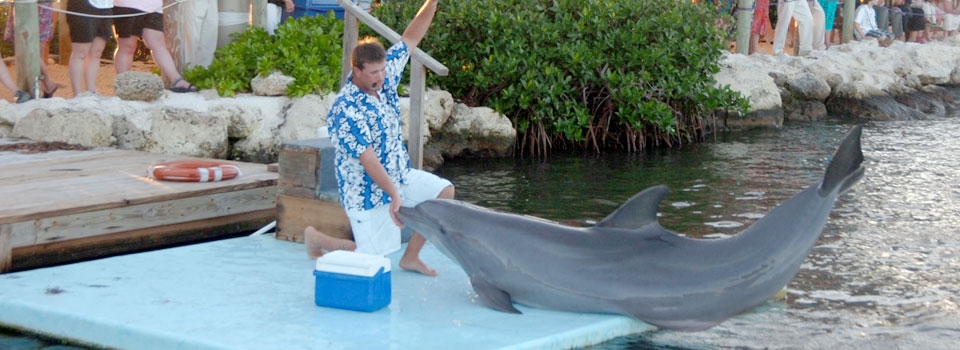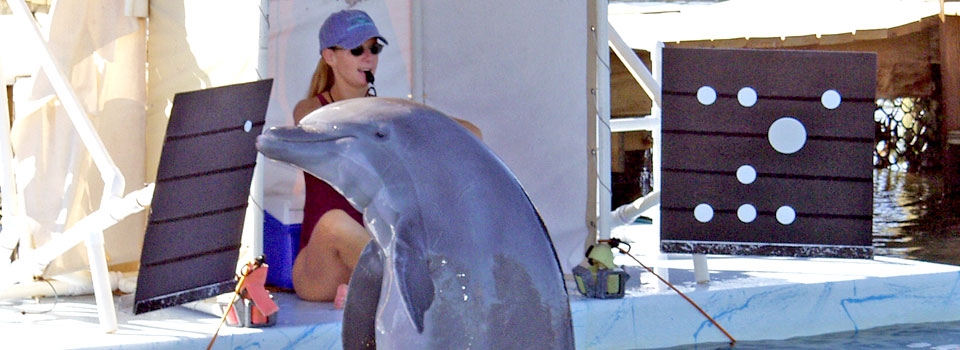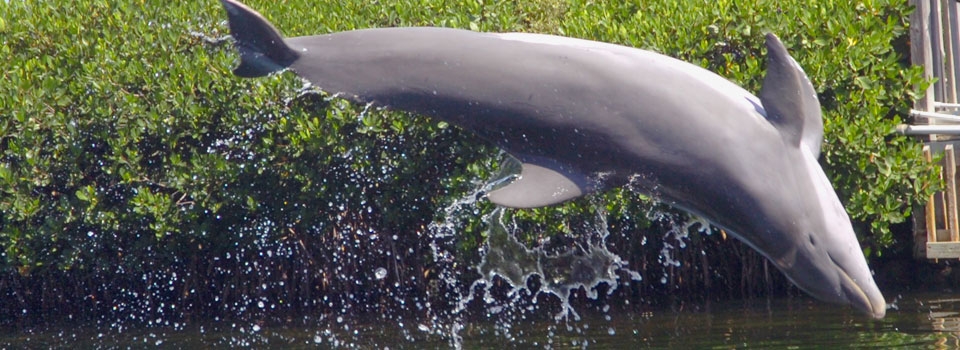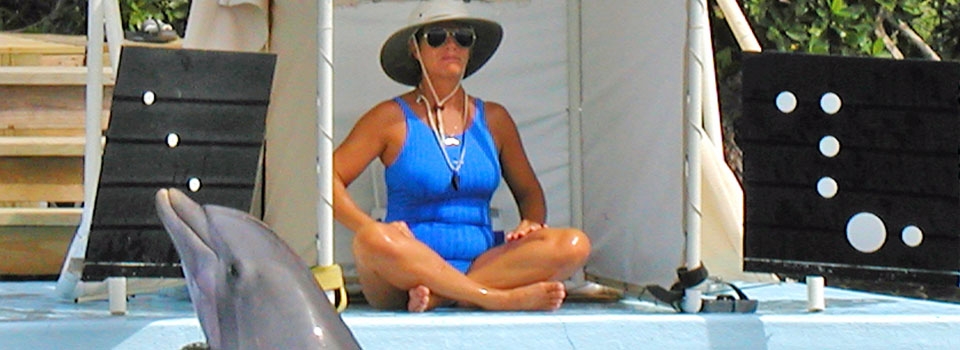- RESEARCH
- LEARN
- Camps »
- Resources »
- Kids Zone »
- SHOP

- Providing Sanctuary and a Forever Home since 1984.
- A not-for-profit 501(c)3 marine mammal education and research facility for more than 35 years.
- Providing Sanctuary and a Forever Home since 1984.
A not-for-profit 501(c)3 marine mammal education and research facility for more than 35 years.
Introduction
Introduction
Training dolphins - it’s the career of many people’s dreams! Almost everyone has either read about dolphins or seen them on television. A few people may have been fortunate enough to observe them in their wild habitat. Many of you probably have seen trained dolphins in person at an aquarium or marine mammal facility. The intelligence and creativity of dolphins make working with them both challenging and a lot of fun. As you watch trained dolphins gracefully perform various behaviors on cue, the trainer’s job may look easy. It seems as though the trainer “directs” and the dolphin “performs”. What you don’t see is all the time, planning, and expertise that go into this unique kind of dolphin-human relationship.
As you read this text, remember that the same basic principles that apply to shaping dolphins’ behavior also apply to other animals, including people. Try using some of these techniques with your family or friends. You may be surprised at how well they work!

Why We Train Dolphins
Why We Train Dolphins
The DRC dolphins demonstrate their individual talents and abilities for our visitors daily in training sessions that take place during public sessions. While educational and fun for our guests, this is not the main reason that we train. The dolphins’ health and happiness is our main priority. Training the dolphins helps us to accomplish this in several ways:
Physical Stimulation: Dolphins are very strong animals and capable of performing amazing physical feats. Many of the behaviors that you see the DRC dolphins do are natural behaviors for dolphins in the wild. However, wild dolphins spend a lot of time and energy swimming and trying to catch their food. At times, they must swim fast to avoid predators like sharks. When their stomachs are full and they are safe, they then have time to frolic and play.
Although the dolphins at DRC occasionally chase and, sometimes, eat the fish in their lagoons, they do not have to work hard at catching food because they realize that it comes to them from the trainers. They also do not have to worry about safety; the perimeter fences that separate their lagoons from the open water are designed to keep sharks out. Since the DRC dolphins do not have to use their energy for everyday survival, it is important that they get the proper physical exercise. An important purpose of training is to keep them active and healthy.
Mental Stimulation: Dolphins and humans both exhibit high levels of cognitive functioning. Just imagine if you never had the opportunity to stimulate your brain by reading a book, playing a game, solving a puzzle, or learning a new skill; you probably would become very bored. Almost everyone loves an occasional challenge, and dolphins are no different. They constantly amaze us with their eagerness and ability to learn new things and to solve problems. The mental stimulation that makes life interesting and fun is also very good for the dolphins. The stimulation of continually learning new things develops a healthy ability to adapt to changes in the environment. Adaptability is important for all animals, including humans!
Medical/Husbandry Applications: Without regular medical checkups, the only way we could assess the dolphins’ physical well being would be by how they act and how much they eat. This is not reliable, since it is instinctive for most animals to hide any illness or injury; many predators take advantage of the sick or weak. Routine checkups can tell us how healthy the dolphins are and allow us to take preventative steps to ensure that they stay healthy.
We have learned at DRC that the dolphins will accommodate many medical procedures voluntarily once the trainers teach them these procedures. Blood, urine, fecal, stomach and blowhole samples are collected from the dolphins by DRC staff and analyzed in the lab. In order to get samples, the dolphins are trained to do certain things, such as holding the tail very still in a trainer’s lap while a blood sample is taken from the large vessels found in the tail flukes. Just as with people, medical samples can tell us a lot about what is going on inside the body.
As is the case with the frozen food we eat, analysis of the fish we feed the dolphins tells us that some nutrients are depleted in the freezing process. To ensure that the dolphins are getting all the proper nutrients, we supplement their diet with vitamins. For some dolphins, we have to stuff the vitamins into their fish, but, through training, many of our dolphins have learned to swallow their pills directly!
Education and Research Applications: We are only just beginning to understand the needs and capabilities of the bottlenose dolphin, let alone all the other species of dolphins and whales with which we share this planet. At DRC, we believe it is important to learn all we can from and about the dolphins in our care, and teach what we know, so that people will have a better understanding and appreciation of these fascinating animals.
While we can learn some things from just observing dolphins, training dolphins allows us to learn much more about their physical and mental functioning. In order to give the dolphins a way to “answer questions,” a system of communication must be established.
For example, you had to learn to read in order to understand this text. In order to communicate with dolphins, we train them to understand and interpret various cues. Training cues can be many things, such as objects, symbols, hand signals, or sounds.
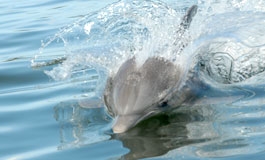
Principles of Training
Principles of Training
There is a lot to learn before a prospective trainer is ready to interact with dolphins in a training capacity. Apprentice trainers at Dolphin Research Center learn their job by working through a series of progressive stages.
Rapport: The cornerstone of all successful training is a strong dolphin-trainer relationship. All DRC trainers begin by simply making friends with the individual members of our dolphin family. An effective trainer will work to develop a bond of trust and will learn what kinds of things each dolphin enjoys. Rapport is built through feedings, play sessions, and dock time. In the early stages of the relationship, trainers must be very observant of the dolphin’s behavior. Trainers should strive to be approachable, gentle, creative, and FUN! The dolphin is also discovering what a particular trainer enjoys. If a trainer has a loud, cheerleader-type personality, the dolphin may respond by becoming loud and animated, as well!
Operant Conditioning: Our method of training dolphins is based on operant conditioning. In the training situation, the dolphin is an “operator,” an active participant who exhibits a behavior to which the trainer then responds. The consequences which follow a behavior directly influence the frequency with which the behavior will be repeated. Training is very much a two-way communication process.
The trainer’s response to the dolphin will either increase or decrease the likelihood that a given behavior will reoccur. If a behavior is followed by something that the dolphin likes, the probability that the behavior will occur again is increased. If the trainer’s response is not agreeable, the dolphin eventually will tend to avoid that particular behavior.
If your mother wants to “train” you to take out the trash, she may use a variety of methods. She may remove privileges or get upset if you don’t take out the trash, or reward you with praise about how nice it is when you do take out the trash. Either punishment or praise may influence how often you take out the trash. However, using a method that incorporates positive reinforcement is most likely to encourage you to take out the trash on a regular basis.
Positive reinforcement has proven to be the most effective means of influencing behavior. If, after you take out the trash, your mother rewards you with a warm smile, a piece of cake, or the car for the day (depending on your preferences), you will be more likely to take out the trash again without being asked. Your behavior has been modified through operant conditioning.
Note: You will notice that we refer to “behaviors” when discussing what we teach the dolphins. When we train dolphins at DRC, we do not teach them to do “tricks”. Tricks imply illusions, things that are not real, but intended to puzzle or amuse. Dolphins are incredible athletes and intelligent mammals; their accomplishments are real. We teach them to do specific behaviors on cue, which we request by giving verbal or hand signals.
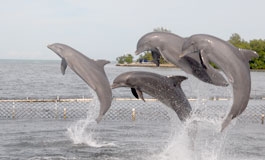
Training Techniques
Training Techniques
Reinforcement: There are two types of reinforcement: positive and negative. Both increase the probability that a behavior will reoccur because both provide a positive consequence for the behavior, although in different ways.
Positive Reinforcement: Provides a positive stimulus, something the dolphins enjoy and desire, as a consequence of the behavior. Positive reinforcement may be PRIMARY (something inherently positive, requiring no learning experiences) or SECONDARY (something that acquires its positive effects through learning experiences). For dolphins and humans alike, food is a primary reinforcement. Therefore, the primary reinforcement for dolphins is usually, but not always, fish.
For many people, a paycheck becomes a powerful secondary reinforcement, because money is associated with so many things we may desire (food, shelter, clothing, power). After learning to read and discovering the pleasure it can provide, a book may become a secondary reinforcement. A dolphin may learn to enjoy playing with a certain toy, and so the toy becomes a secondary reinforcement. At DRC, the sound of the crowd cheering for the dolphins has become a unique secondary reinforcement for many of them.
Some people find affection and hugs rewarding; others might find quiet and solitude rewarding. Everyone is different. Knowing the personality of each dolphin is important because individual preferences vary. Praise and applause seem to be highly rewarding for many dolphins. Some like to play with toys, others prefer back rubs or having their trainer go for a swim with them, while others may enjoy doing their favorite behavior.
Primary and secondary reinforcements are randomly intermixed throughout the session, keeping it unpredictable and fun for both trainer and dolphin.
An intermittent or partial schedule of reinforcement, with variable or random amounts of reinforcement given in a random way, produces the strongest results. One fish after every behavior is boring and predictable, so instead, trainers vary frequency, size and type of reinforcer. Sometimes trainers surprise the dolphins with “Jackpots”—handfuls of fish. Your attention level stays higher if you never know when you might hit the jackpot.
Negative Reinforcement increases the future probability of a behavior because a negative stimulus is removed as a consequence of the behavior. A dolphin can achieve a reinforcing consequence by performing some action, which causes an undesirable stimulus to be removed. The situation may be as simple as the dolphin making a move to avoid an object they don’t like.
For example, a trainer might be attempting to teach a dolphin to go through a gate into an adjoining pool. He might wish to positively reinforce any movement toward the pool; but if the dolphin never moves in that direction, there will be nothing to positively reinforce.
However, if the dolphin tends to avoid things, the trainer might try using an unusual object, such as a plastic chair, to create a situation in which the dolphin can receive negative reinforcement. When the trainer splashes the chair into the water, the dolphin may retreat into the next pool due to the novelty of this object. The behavior is achieved because the dolphin wants to avoid the undesirable stimulus: contact with the unusual object. The dolphin receives a desirable, reinforcing consequence (a pool with no chair in it) for the behavior. Positive reinforcement (such as fish or praise) for the desired movement can then also be offered, further reinforcing the behavior.
Nonreinforcement
Even with all of the correct tools for training, there is no guarantee that all of the dolphin’s behavior will be positive, or something the trainer wants to reinforce. In dolphin training, you look for the behavior or steps in a behavior that you can positively reinforce, and ignore behavior that is undesirable or “not on the right track”. If the dolphin is offering behavior that is undesirable for some reason, not allowing any stimulus, positive or negative, to follow the behavior tends to extinguish that behavior.
Nonreinforcement decreases the likelihood that a behavior will be repeated because the behavior is not followed by a positive consequence.
Punishment is nonreinforcing a behavior by presenting a negative stimulus as a consequence of the behavior. We choose not to utilize this method in working with the dolphins. As dolphin/human relationships at DRC are based on trust and the enjoyment of each other’s company, we do not believe punishment would be an appropriate way of influencing dolphin behavior and, therefore, has no place in our work with dolphins.
Time Out: Sometimes, to decrease an undesirable behavior, trainers utilize a procedure called a time out. A time out is nonreinforcing a behavior by removing any positive stimuli from the trainer. The time out serves to decrease the future probability of the behavior it follows. One situation in which a time out may be used is when a dolphin is exhibiting inappropriate behavior such as chasing another dolphin away from the dock during a session. The trainer will calmly turn their back to avoid even the reinforcement of eye contact, or will leave the dock altogether. The dolphins will not be as likely to chase one another at the dock if they lose all attention and other reinforcement from the trainer as a result.
Another situation in which a time out might be implemented could involve a dolphin that refuses to do a behavior it apparently knows. Rather than try to re-train the behavior (which would be an insult to the dolphin’s intelligence), the trainer may simply decide to take a time out. In this case the time out is communicating, “We both know you can do this. Let’s take some time to think about it and we’ll try again later.”
Time outs vary in length. When used appropriately, time outs can be a very effective training technique, because we have seen the dolphins try to elicit our attention. They may vocalize or even throw seaweed at us, to get us to come back. It may be hard not to respond, but if we did, the dolphins would be shaping our behavior and it would defeat the purpose!
It is interesting to note that dolphins also use the time out technique with us. For instance, if during dock time (a non-training, free time visit to a dolphin’s dock) a person exhibits behavior the dolphin doesn’t like (such as reaching out to him repeatedly when the dolphin is not in the mood to be touched), the dolphin will respond by removing itself from the vicinity of the dock and ignoring the visitor.
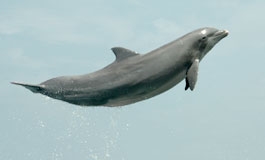
Training Tools
Training Tools
Bridge: In order for operant conditioning to be successful, you must somehow inform the dolphin that they are doing the appropriate thing, while they are doing it. If a dolphin is jumping twenty feet away from the trainer, it would be almost impossible to offer a fish or some other reinforcement at the exact moment the dolphin does the behavior correctly. Instead, in early training, the sound of a whistle is associated with rewards of fish and praise. The dolphins quickly learn that when they hear the whistle, they have done the behavior correctly and they can return to the dock for their reward. Therefore, the sound of the whistle becomes a conditioned reinforcer that serves to BRIDGE the gap in time between the instant the dolphin does the correct behavior and when the dolphin receives its reward. That is why we call the sound of the whistle a “bridge”.
Learning to bridge correctly with a whistle may be one of the biggest challenges for a new trainer. The whistle must be blown at the precise instant the behavior is correct in order for it to be effective in letting the dolphin know, “YES! That’s great! That’s exactly what I’m looking for!”
Recall: Another important acoustic tool that the trainer uses is the recall. The recall can come in many forms. It can be a tap on a bucket or cooler, an underwater sound, or even a splash on water by your hand. There are times during the training session when the trainers need to use the recall sound. The dolphins may be away from the dock for a variety of reasons—the trainer may have misdirected them, they may be sidetracked, or they may be performing a behavior that is incorrect or below bridging criteria. The trainer can utilize the recall to ask the dolphin to return to the dock for redirection.
One of the strongest underwater sounds that we train is a pinger recall. The pinger is a special frequency sound that travels long distances underwater. The dolphins are taught that if they hear this sound, they are to respond no matter what they were doing. Because of our location in the Gulf of Mexico, we want to be able to call the dolphins back to us if they should ever find themselves outside of our lagoons and in open water. This could happen in the event of a hurricane, for example. If our perimeter fences were damaged and the dolphins swam out and got “lost”, the pinger would be their guide to lead them to safety and home.
Stationing: Before giving a hand or verbal signal, the trainer first must get the dolphin’s attention. At DRC, the dolphins learn to STATION when the trainer positions an index finger up in front of them. The trainer expects the dolphin to look up at them, head vertical, eyes above the water. This tells the trainer they have the dolphin’s complete attention.
Target: A target is used to indicate location or position to a dolphin. The dolphin is taught to touch a target such as a trainer’s palm or a ball on the end of a pole (known as a target pole). Moving the target and bridging when the dolphin touches it pinpoints a critical location or point of the behavior. The target pole can be used as an extension of the trainer’s arm, helping to shape behaviors farther away from the dock.
Symbol: Although not a standard training tool, symbols are frequently used at DRC. Dolphins have a personal symbol, a shape we put in the water to let the dolphin know where they are going to be. The symbol can be any shape or material and is used to denote where (i.e. at which dock or pool location) each dolphin’s session will begin.
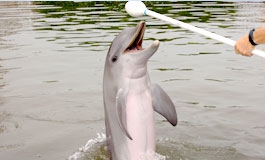
Methods of Training
Methods of Training
There are several general methods used to teach behaviors to a dolphin. In order to get to the end product, the trainer usually must find a way to prompt the dolphin into doing the behavior, or a step toward the behavior. Some methods work best for certain behaviors and some methods work best with particular dolphins. Deciding which training method to use is at the discretion of the trainers and depends on what they feel will work in a given situation.
Direct Manipulation, by physically maneuvering a dolphin through the desired motion, then reinforcing the behavior, is one method of training. For example, if the trainer wants two dolphins to touch their rostrums in a “kiss,” he/she may gently push the dolphins’ rostrums together until they touch, then bridge at the touch. Direct manipulation is not used often with dolphins because of the difficulties presented by their size and in-water habitat.
Imitation or Modeling: A trainer may model the behavior for the dolphins and reinforce imitation of that behavior. The imitation method might be used to train a dolphin to mimic sounds or behaviors such as bobbing up and down. Once the concept of imitating on cue is learned by the dolphins, you can then ask the dolphins to imitate other dolphins, sea lions, or people—at DRC, sometimes members of our public tours.
Targeting uses a tool such as the trainer’s hand or the target pole to shape a behavior. Once a dolphin has been taught to touch targets, the trainer can use the hand or pole to maneuver the dolphin into doing various movements that can then be reinforced. For example, to teach a dolphin to nod his head “yes,” the trainer asks the dolphin to target on their hand, and then moves the hand in an upward and downward motion while the dolphin’s rostrum is targeted on it. By reinforcing the movement and pairing with a signal, the dolphin will eventually move his head up and down on signal without the hand target present.
Successive Approximations shape a behavior by encouraging and reinforcing (often using targeting and bridging) small steps that lead in the general direction of the final behavior. The dolphin is rewarded for behavior that gradually looks more and more like the desired end result, while behavior that deviates from the desired end-point is ignored. The trainer may use successive approximations to refine behavior already known (such as encouraging higher dives) or to begin new behavior training (refer to the “Sample Behavior Chain” which follows for an example).
Opportunistic Training/Capturing: Some of the first behaviors dolphins learn to exhibit on signal are spontaneous behaviors that do not involve any initial prompting by the trainer. The trainer sees the dolphin exhibit a desirable behavior that occurs spontaneously, and immediately bridges and reinforces it, showing the new signal they wish to pair with that behavior. Trainers must be ready at all times because the dolphins often exhibit such behaviors between session times.
As you will read in “Training A New Behavior” (below), generally one trainer will work on a new behavior with a dolphin, but in the case of opportunistic training, everyone helps out. It is important to try to catch the behavior as many times as possible, and the dolphin may offer the behavior at any time, in and out of sessions. If the behavior is reinforced and the new signal shown consistently, soon the dolphin will associate the new signal that has been given with the behavior it has just exhibited, and you now have a new behavior added to that animal’s repertoire.
Opportunistic training is often used to get vocals on signal, since it is impossible to physically manipulate a dolphin to produce a certain sound. For example, all the trainers began to show one of our dolphins the same hand signal every time she offered her signature whistle, and we now can ask her to give this unique whistle on cue. Since dolphins are extremely innovative, the opportunistic method of achieving new behaviors is very popular with them (and fun for us).
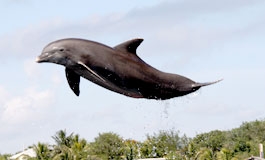
Training Session Techniques
Training Session Techniques
Before beginning a session on the dock, a trainer should be aware of the following techniques that will help ensure a successful experience for both trainer and dolphin.
The trainer must go down onto the dock both physically and mentally prepared for the session. This means having all the essential tools, plus any additional props that may be needed. They must leave any excess mental baggage (worries, stress) behind and have their attention focused on the dolphin. The trainer should have good, erect posture, and a positive “we are going to have a great time!” attitude, which set the stage for a positive learning experience.
Trainers working simultaneously with different dolphins in the same lagoon begin and end each session at the same time. Most dolphins are curious and social creatures. If one dolphin is getting a trainer’s undivided attention, other dolphins that are not occupied may vie for it as well, which can cause the training session to end in chaos. Therefore, each dolphin or team of dolphins in a pool works with their trainer simultaneously to create harmony during sessions.
Good trainers avoid routine, and never start or end sessions in the same way. Trainers try to be “consistently inconsistent,” which challenges both the dolphin and the trainer.
If a session is not going well, the trainer can always leave and come back later. It is better for a trainer to leave and collect her thoughts than to continue a session feeling frustrated. Good trainers try to end the session on a positive, high note. A new step in training successfully mastered, or a known behavior performed beautifully are both good ways to end a session. The goal is for both the trainer and the dolphin to feel great about the session, and want more interaction. This way the dolphin will eagerly anticipate the next training experience, and so will the trainer.
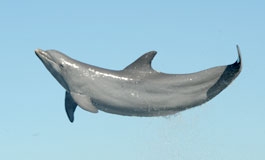
Training A New Behavior
Training A New Behavior
Initially, an apprentice trainer practices the techniques he is learning by maintaining behaviors that the dolphins already know. After the apprentice has mastered the basics and understands the concepts we have discussed thus far, he is ready to train a new behavior.
The first step in any new training is to write a behavior chain. A behavior chain is a specific plan of action that details each training step leading to the desired final behavior. Writing a behavior chain requires the trainer to think through the entire process. Planning is important because once a trainer is on the dock training the dolphin, they will not want to take precious time and risk losing the dolphin’s attention by stopping to think out the next step in the progression. Sometimes a dolphin learns quickly, so a good trainer will be ready to move on. If, on the other hand, the dolphin is confused, the trainer must be ready to offer an understandable alternative. By creating a behavior chain ahead of time, the trainer is prepared and confident when teaching the dolphin.
Generally, a trainer works one-on-one with a dolphin until a new behavior is completed. In initial training, progress may be in small increments, and it is difficult to communicate the nuances of the dolphin’s actions effectively between two or more trainers. Having different people training the same behavior to the same dolphin could be confusing for the dolphin. There are some exceptions to this rule, as in the case of opportunistic training when all the trainers work to associate a spontaneous behavior with the chosen signal.
In new training, trainers tend to rely mostly on primary reinforcement, but many dolphins get more excited over the trainer’s secondary reinforcement. Secondary reinforcement includes praise, applause, and often the trainer’s own excitement over the dolphin’s new accomplishments.
How long does it take to teach a new behavior? It depends on the dolphin, the complexity of the behavior, the trainer, and how often sessions are available to work on the behavior. It is usually better to teach many short lessons than a few long ones. Some dolphins take to learning certain kinds of behaviors more quickly than others; they all have their preferences.
When learning a new behavior that they particularly like, the dolphins often will spontaneously deliver, or “ad-lib,” the behavior during other sessions, or even between sessions.
If you would like to write your own behavior chain, follow these steps :
- Decide on a behavior you would like to train. Remember to be realistic, especially if this is your first training attempt. Many creative behaviors can be trained easily, making the early training experience positive for both trainer and dolphin.
- Devise a signal for the new behavior that does not resemble any signals the dolphin already knows. Some trainers find this to be one of the more difficult steps!
- Visualize what the final product will look like. It is important that you know exactly what to look for so there will be no hesitation in your bridging. Timing is everything!
- Break down the behavior to determine what steps will be necessary to lead to the final result. List the steps numerically, from the first, most basic building block to the finished behavior.
- Decide what method you will use to teach each step. Keep in mind what behaviors the dolphin already knows that may help you train the new behavior. For example, when DRC’s Delphi learned to paint, the trainer first taught him to hold a special brush in his mouth. The next step was to have Delphi move his head while holding the brush. Delphi already knew the “yes” and “no” behavior, so the trainer simply gave the signal for the known behavior while Delphi was holding the brush. These shortcuts can help speed training time, and give the dolphins confidence because they are secure with known behaviors.
- Write down alternative methods in case your first method is unsuccessful. A back-up plan is always necessary because you cannot be sure how the dolphin will react. What seemed perfectly easy to understand written out at your desk may result in the dolphin giving you a blank stare during a session. Be prepared to offer another alternative route to the same end goal.
Sample Behavior Chain
DOLPHIN: Pax BEHAVIOR: Flip
TRAINER: Lindsay START DATE: 4/6/00
SUPERVISOR: Linda DATE COMPLETED: 1/12/01
Signal: With right hand, touch tip of index finger to tip of thumb (forming a circle), other three fingers extended straight up. Should look like the “Okay” sign.
Steps for Behavior
- Station and show new signal.
- Tap long target pole on the water’s surface to the left of the dock. When Pax touches it, bridge.
- Repeat Steps 1 and 2, except this time, as soon as Pax touches the target, pull the target along the surface to the front of the dock. When Pax follows, push the target under the water and make a circular motion. As Pax tucks his head to follow the target, bridge.
- Repeat Steps 1-3. Encourage Pax to follow the target and actually do an underwater somersault with it. Bridge when he tucks and continues to follow the target around under water.
- Repeat Steps 1-4. Once Pax is going all the way around in a circular motion, begin raising the target slightly out of the water. Pax should raise his head up to the target, then follow the target as it is pulled forward and down fast to do the underwater somersault motion. Bridge for his head movement forward and down.
- Repeat Steps 1-5. Since every step begins with Pax starting out to the left some distance, he should get the idea that he will need a run to gain momentum for this behavior. Start phasing out the tap to the left to see if Pax will do the swim to the left without the target. (This is the beginning of teaching a “run,” a pass to build up speed for an aerial behavior.)
- Repeat Steps 1-6. Start gradually raising the target higher and higher. Bridge when Pax comes up to the target, does his chin tuck, and starts to fall over (i.e. at the peak height of his tuck.)
- Begin bridging for a good tuck position. This will result in a fast, good revolution flip.
- Once Pax is doing the somersault out of the water, while following the target, the next step is to remove the target. Signal for the flip, and as Pax approaches quickly, move the target out of the way before he can reach it. Bridge if he tucks on his own. At this point, reduce other criteria (tight tuck) until Pax is initiating the tuck on his own without the target cue.
- As the target pole is being phased out, start slowly expecting better form (tight tuck, good revolution). Bridge for form first, and once that is mastered, shape height by bridging for the highest flips.
- Final step is to shape the placement of the flip in the lagoon. To encourage Pax to do the flip away from the front of the dock, give the signal from the boardwalk or beach area. Bridge flips done in center of pool. If this is not successful, try training placement of the behavior using ice cubes as markers. Train Pax to go where the ice cubes hit the water, and to do the flip in that location. Write another behavior chain for that plan if it becomes necessary.
Note: You can see from this behavior chain that Pax is an experienced dolphin. He has already learned a strong target-follow behavior, allowing the trainer to move right into the shaping of the flip.
Also note the two alternatives for placement of the flip at the end of the behavior chain. This is far along in the training of the behavior, so the trainer can plan details of the alternatives as the training progresses.
Incorporating New Training Into A Session
New training can be incorporated into any training session, at any time in the session. The trainer may want to begin with the new training, catching the dolphin’s initial eagerness for the session. Other times he may decide to work on known behaviors first, working on the new behavior later in the session. This decision is totally up to the trainer. Many good trainers assess the dolphin’s attention and energy levels at the start of the session and base their decision on that. Remember, variety makes a session interesting.
To begin training, the trainer will station the dolphin and show the new signal. The dolphin generally will give the trainer a blank stare, or the dolphin’s eyes may widen with curiosity. If the dolphin offers a behavior after the signal, then the new signal may be too close to one he already knows.
From this point on the trainer will implement the behavior chain she has written. One of the hardest things to remember is to quit while you are ahead. The trainer must remember there are many sessions available to complete the behavior, and not to rush it. The rule of ending each session on a high note is especially important with new training.
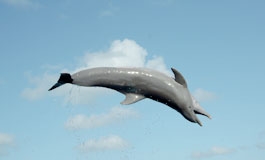
Advanced Training
Advanced Training
As you become more comfortable working with the dolphins, new training techniques become easier. You can begin to challenge yourself and the dolphins with more complex sessions.
Alternate Bridging
At times the whistle we use as the conditioned reinforcement may not be appropriate (for instance, in situations where the dolphin’s ear is very close to the trainer), so we must find another method to bridge the gap in time between the peak of the behavior and its reinforcement. At DRC we teach a dolphin to recognize a double tap of our hand on his back or side as a substitute-conditioned reinforcement.
Initially, the double tap is given with the whistle bridge immediately following it. Once the dolphin responds to the double tap, we start eliminating the whistle.
Group Behaviors
Group behaviors are fun and exciting to watch. The training of them can be just as exciting. There are two methods we use at DRC when asking a group of dolphins to perform a behavior together for the first time.
a) Start with each dolphin having his or her own trainer at the same dock. The trainers then give the dolphins the same signal simultaneously.
b) One trainer gives the signal with all the dolphins at the same dock.
Even though each dolphin knows the behavior, there are other elements involved when asking him or her to execute the behavior in a group with other dolphins. The first goal is for all the dolphins to perform the correct behavior, whether they are coordinated with each other or not. We might then start adding other criteria. For example, if we want to be able to ask a group of dolphins to execute beautifully synchronized high dives out of the water, at first we would bridge when they all did a dive on signal, no matter where they were in the pool. We might then look for them to be closer together, going in the same direction, getting the form better, and finally we may look for height. Each criterion is shaped individually before moving on to the next criterion. When introducing something new to an established behavior, you must initially relax your previous standards for bridging that behavior.
Medical Behaviors
Medical behaviors may be the most important part of training at DRC. Medical behaviors usually involve asking the dolphins to lie still on the surface of the water. Medical behaviors therefore may take more time and patience to train.
Trust is the key to training medical behaviors. Desensitizing a dolphin to the prick of a needle, a tube sliding down the throat, or holding still for an external exam can be very challenging. We never trick the dolphins. We always let them see what we are going to do—such as showing the needle to get a blood sample. As the dolphins learn what we are trying to do, they relax and cooperate with the procedure. As with all behaviors, it is of the utmost importance to understand the preferences of the individual dolphin, and incorporate that understanding into how you proceed.
Initially during the training of medical behaviors, we simulate how the final behavior will be accomplished. For instance, to take a blood sample, we generally need two people aside from the trainer to help in the process, a cooler to store the blood, and a box containing the medical equipment. We include the introduction of these items in our behavior chain so that the dolphins get used to having them around.
Research Training
Research studies usually involve some of the most challenging training for both dolphin and trainer. It is critically important to design the study so you know that the question you are trying to ask is the one the dolphin is trying to answer. A great deal of time and thought goes into how we will get the question across.
As in any research, in a study with dolphins you must control as many variables as possible to achieve reliable results. Dolphins, for instance, may look for “social cuing”; that is, they will watch their trainers very closely and figure out the answer from even the subtlest body language. For example, if you have two paddles in the water, and the paddle on the right indicates the correct answer, the trainer’s eyes may unconsciously move toward that paddle. The dolphin is watching the trainer’s eyes so closely he sees that cue, and presses the paddle on the right. In this case, to avoid social cuing the trainer would need to be behind a screen or wearing goggles so the dolphin couldn’t see her eyes.
Another situation in which research results may be invalidated is when the subject, in this case, the dolphin, develops a bias. One way that bias can creep into a research study is by varying the reward for correct responses. Inadvertently giving a larger reward for moving in a certain direction may encourage the dolphin to develop a preference for moving in that direction, resulting in inaccurate data. A consistent reward (such as two fish for every correct response) prevents the dolphin from developing a bias towards any particular response.
The challenges in research training are many, but the rewards are great. Very gradually, we are learning more and more about the capabilities and needs of our dolphin friends. The dolphins seem to have a great deal of fun figuring out the puzzles we present to them.
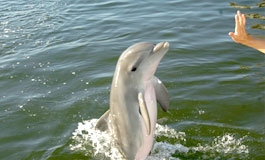
Training References
Training References
Blackman, Derek. 1974. Operant Conditioning: An Experimental Analysis of Behavior.
Methuen & Co: London, England.
Freedman, Russell and James E. Morriss. 1969. How Animals Learn. Holiday House: New York, NY.
Pryor, Karen. 1975. Lads Before the Wind: Adventures in Porpoise Training.. Harper and Row,
New York, NY.
Pryor, Karen. 1985. Don’t Shoot the Dog. Bantam.
Pryor, Karen. 1995. On Behavior: Essays and Research. Sunshine Books: North Bend, WA.
Ramirez, K. 1999. Animal Training: Successful Animal Management Through Positive
Reinforcement . Shedd Aquarium: Chicago, IL.
Reynolds, G. S. 1975. A Primer of Operant Conditioning. Scott, Foresman, and Co: Palo Alto, CA.
Sutherland, N. S. and N. J. Mackintosh. 1971. Mechanisms of Animal Discrimination Learning.
Academic Press: New York, NY.
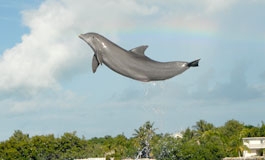
Our Mission -
Through education, research and rescue, Dolphin Research Center promotes peaceful coexistence,
cooperation and communication between marine mammals, humans and the environment we share with
the well being of DRC's animals taking precedence.
